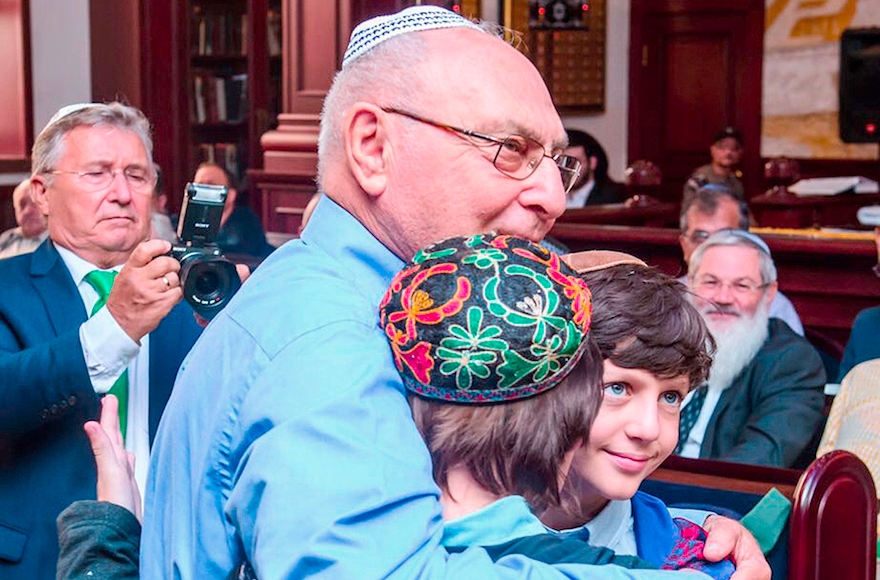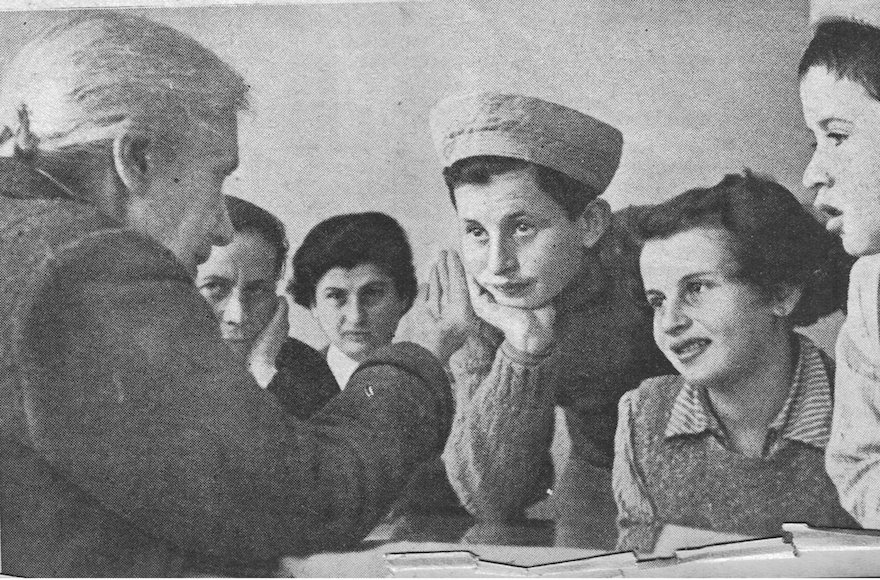Tehran Holocaust refugees generating new interest amid global migrant crisis
Published January 23, 2017

Ephraim Lapid hugging the children of Yanush Ben Gal in Kazan, Sept. 4, 2016. (Limmud FSU)
SAMARKAND, Uzbekistan (JTA) — After starving for months in Siberia, 5-year-old Natan Rom thought he was in paradise when he arrived in this colorful trading hub in Central Asia.
ADVERTISEMENT
It was 1940, and Rom, along with his parents and older sister Ziva, was one of countless Jewish refugees who arrived in Samarkand after fleeing the Nazis eastward from their native Poland.
“I remember the heat, the wonderful warmth after the cold in Siberia and the heaps of food in market stalls: nuts, berries, apricots,” Rom, now 88, told JTA.
The joy would be short-lived.
In a city awash with refugees, Rom and hundreds of other Jewish children were met with indifference and hostility, forced to beg and steal in a city oblivious to their plight. Rom would lose his father to starvation in Uzbekistan before the British finally allowed him and Ziva to enter Tehran in 1942 en route to prestate Israel.
The siblings were among the approximately 800 Tehran Children, a group who reached prestate Israel following a tormented journey through the Soviet Union, India, Egypt and Iran.
Their largely forgotten trials are now drawing renewed interest from Jewish groups, historians and filmmakers who recognize the significance of their story in a world again struggling with the moral dilemma of war refugees.

Hadassah founder Henrietta Szold meeting with Tehran Children in Israel in February 1943. (Jewish Agency for Israel)
ADVERTISEMENT
They have been the subject of two documentaries, one of which featured Ziva Rom bitterly recalling how the children posed as models for Samarkand art students who “wanted to sketch starving children.” Last year, the educational group Limmud FSU organized an event in the Russian city of Kazan that highlighted the children’s stories. And in September, a 2007 film about the children had its first screening outside Israel at an event in Moscow also organized by Limmud FSU.
Not since the Holocaust has the twofold lesson of the Tehran Children been more relevant than today, said Chaim Chesler, Limmud FSU’s founder and a former Jewish Agency treasurer.
“We can rely only on ourselves, especially in catastrophes of massive scale,” Chesler said. “But on the other hand, their harrowing journey also underlines the crucial duty of remaining open and sensitive to the plight of refugees.”
The Rom children learned early the consequences of dependency. Their parents, Ethel and Karol, had another son, 2-year-old Uzi, and not enough food to sustain three children. So they gave the two older siblings to a local orphanage.
Giving up his own food for his wife and youngest son, Karol wasted away until he became terminally ill. Hours before Zionist activists evacuated the Tehran Children to Iran, his two older children came to bid their father a last goodbye. Rom remembers seeing his father for the last time, an emaciated man feebly leaning against the doorframe of the squalid hut where he lived with his wife and infant son.
Rom and his sister, who eventually were reunited with their mother and youngest sibling in Palestine, recently found their father’s grave at Samarkand’s Jewish cemetery. They made a Hebrew-language headstone for him that says he “starved to death as a refugee.”
Other members of the Tehran Children never found their parents’ graves. Avraham Raz, who died in 2014, said in the 2007 documentary, titled “The Children of Tehran,” that he felt relief on the day he helped bury his father in an unmarked grave after he died of typhus in Samarkand.
“It’s unpleasant to admit, but it meant more food for my mother and me,” Raz said. “Neither of us cried.”
As more and more Jewish parents in Uzbekistan became unable to feed their children, 1,000 kids were put up for adoption — mainly to convents and orphanages. Some, including Yanush Ben Gal, were allowed to stay in the army camps of Polish soldiers fighting alongside the Allies. Uncared for, they would fight among themselves for the mattresses and food dumped in a trough by the soldiers.
Ben Gal, an Israel Defense Forces general and war hero who died last year, remembered as a 5-year-old pouring lime on the latrines as part of his duties.
“By the time I reached boot camp in the IDF I was already an expert at this,” Gal said in the film.
Some Tehran Children say they see their younger selves in the hundreds of thousands of immigrants who have made it to Europe from the Middle East since 2014. Ziva Rom said she was reminded of her own ordeal when she saw Lebanese civilians streaming out of their homes amid Israeli bombardments against Hezbollah in 2006.
But others object to any analogy between Arab immigration into Europe and their own trials.
“The Muslim migrants arriving to Europe are for the most part not refugees but job seekers who belong to what is de facto an invasion,” Natan Rom told JTA in September after the Russian screening of the film. Attempts to “pass off “ the new arrivals “as refugees and then to liken their experiences to what Holocaust survivors had to endure is false,” he added.
By 1942, when news about the Tehran Children reached Zionist authorities, their reaction was to send agents to retrieve the children. Meanwhile, international pressure was mounting on the British to make a humanitarian exception to their embargo on Jewish immigration to prestate Israel.
Some orphans staying with Christians would recite Yiddish nursery rhymes while pretending to pray for Jesus. Raz recalled that some even said Jewish prayers in secret “to remember who we were.”
But 200 of the Polish Jewish children who fled to Uzbekistan were never found. It is assumed that those who survived were raised as Christians or Muslims.
In Israel, the Tehran Children were eligible for restitution from Germany. But without parents and unaware of their rights, many of them never made claims. In a 2014 class action suit against the Israeli government, 217 of them obtained a symbolic compensation of approximately $6,000 per person – a fraction of what they estimate they could have claimed had they been made aware of their rights in time.
Still, an outsized proportion of the Tehran Children took on public roles in their young country.
Ben Gal, who headed the IDF Northern Command, served together with Haim Erez, a fellow member of the Tehran Children who controlled the Southern Command. Rom and his sister were among the founders of kibbutzim. And Raz was a senior inspector in the Education Ministry.
“I think the journey snuffed their childhoods and scarred them for life,” said Dalia Gutman, the maker of the 2007 documentary, who interviewed dozens of Tehran Children. “But it also steeled them and gave them fortitude matched by few other groups in Israel’s history.”















